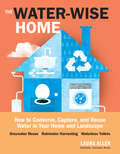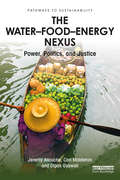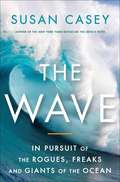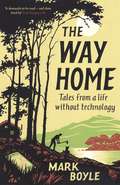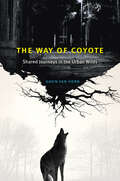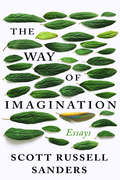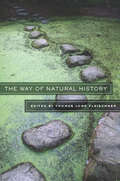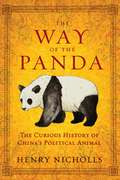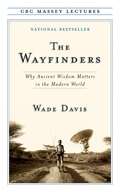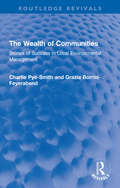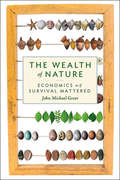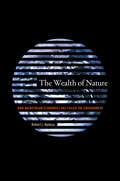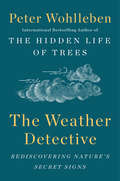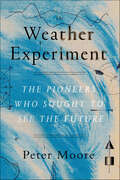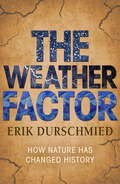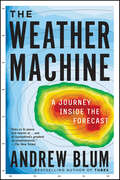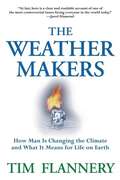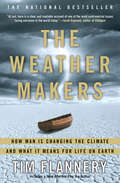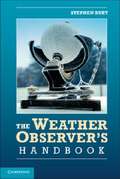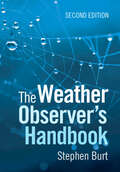- Table View
- List View
The Water-Wise Home: How to Conserve, Capture, and Reuse Water in Your Home and Landscape
by Laura AllenSave the earth’s most precious resource while also saving yourself money. Laura Allen provides expert strategies for using water smartly and efficiently while fulfilling all of your home and garden needs. Learn how to create a water-wise landscape, reuse greywater, harvest rainwater, and even set up a waterless composting toilet. Offering proven techniques in clear and accessible language, The Water-Wise Home makes it easy to help the environment and lower your household operating costs through conserving water.
The Waterside Ape: An Alternative Account of Human Evolution
by Peter Rhys EvansWhy are humans so fond of water? Why is our skin colour so variable? Why aren’t we hairy like our close ape relatives? A savannah scenario of human evolution has been widely accepted primarily due to fossil evidence; and fossils do not offer insight into these questions. Other alternative evolutionary scenarios might, but these models have been rejected. This book explores a controversial idea – that human evolution was intimately associated with watery habitats as much or more than typical savannahs. Written from a medical point of view, the author presents evidence supporting a credible alternative explanation for how humans diverged from our primate ancestors. Anatomical and physiological evidence offer insight into hairlessness, different coloured skin, subcutaneous fat, large brains, a marine-type kidney, a unique heat regulation system and speech. This evidence suggests that humans may well have evolved, not just as savannah mammals, as is generally believed, but with more affinity for aquatic habitats – rivers, streams, lakes and coasts. Key Features: Presents the evidence for a close association between riparian habitats and the origin of humans Reviews the "savannah ape" hypothesis for human origins Describes various anatomical adaptations that are associated with hypotheses of human evolution Explores characteristics from the head and neck such as skull and sinus structures, the larynx and ear structures and functions Corroborates a novel scenario for the origin of human kind ‘… a counterpoint to the textbooks or other books which deal with human evolution. I think readers will see it as a clearly written, well-supported discussion of an alternativeperspective on human origins’. —Kathlyn Stewart, Canadian Museum of Nature, Ottawa ‘There is a pressing need to expand discussions of human evolution to includenon-anthropocentric narratives that use comparative data. Dr Rhys-Evans’ specific expertise and experience with the human head, neck, ears, throat, mouth and sinuses, provides him with a distinct perspective from which to approach the subject of human evolution. Moreover, his understanding of non-anthropocentric views of human evolution (water-based models), allow him to apply a biological approach to the subject, missing in more traditional (savannah-based) models’. —Stephen Munro, National Museum of Australia
The Water–Energy–Food Nexus: Concept and Assessments (Environmental Footprints and Eco-design of Products and Processes)
by Subramanian Senthilkannan MuthuWater, Energy and Food are the very basic necessities of human life and all the three of them are interconnected with each other, this connection being called the Water-Energy-Food nexus. Water is an inevitable element to energy and food systems to work. Water is essential for the growth of crops and produce energy and it consumes a lot of energy to treat and move water. Food and energy are equally dependent upon each other as well. This book highlights with various examples and case studies from around the World, the importance of this concept.
The Water–Food–Energy Nexus: Power, Politics, and Justice (Pathways to Sustainability)
by Carl Middleton Dipak Gyawali Jeremy AlloucheThe world of development thinkers and practitioners is abuzz with a new lexicon: the idea of "the nexus" between water, food, and energy which is intuitively compelling. It promises better integration of multiple sectoral elements, a better transition to greener economies, and sustainable development. However, there appears to be little agreement on its precise meaning, whether it only complements existing environmental governance approaches or how it can be enhanced in national contexts. One current approach to the nexus treats it as a risk and security matter while another treats it within economic rationality addressing externalities across sector. A third perspective acknowledges it as a fundamentally political process requiring negotiation amongst different actors with distinct perceptions, interests, and practices. This perspective highlights the fact that technical solutions for improving coherence within the nexus may have unintended and negative impacts in other policy areas, such as poverty alleviation and education. The Water–Food–Energy Nexus: Power, Politics and Justice lays out the managerial-technical definitions of the nexus and challenges these conceptions by bringing to the forefront the politics of the nexus, around two key dimensions – a dynamic understanding of water–food–energy systems, and a normative positioning around nexus debates, in particular around social justice. The authors argue that a shift in nexus governance is required towards approaches where limits to control are acknowledged, and more reflexive/plural strategies adopted. This book will be of interest to academic researchers, policy makers, and practitioners in the fields of international development studies, environmental politics, and science and technology studies, as well as international relations.
The Wave: In Pursuit of the Rogues, Freaks and Giants of the Ocean
by Susan CaseyFrom Susan Casey, bestselling author of The Devil's Teeth, an astonishing book about colossal, ship-swallowing rogue waves and the surfers who seek them out. For centuries, mariners have spun tales of gargantuan waves, 100-feet high or taller. Until recently scientists dismissed these stories--waves that high would seem to violate the laws of physics. But in the past few decades, as a startling number of ships vanished and new evidence has emerged, oceanographers realized something scary was brewing in the planet's waters. They found their proof in February 2000, when a British research vessel was trapped in a vortex of impossibly mammoth waves in the North Sea--including several that approached 100 feet. As scientists scramble to understand this phenomenon, others view the giant waves as the ultimate challenge. There are extreme surfers who fly around the world trying to ride the ocean's most destructive monsters. The pioneer of extreme surfing is the legendary Laird Hamilton, who, with a group of friends in Hawaii, figured out how to board suicidally large waves of 70 and 80 feet. Casey follows this unique tribe of people as they seek to conquer the holy grail of their sport, a 100-foot wave. In this mesmerizing account, the exploits of Hamilton and his fellow surfers are juxtaposed against scientists' urgent efforts to understand the destructive powers of waves--from the tsunami that wiped out 250,000 people in the Pacific in 2004 to the 1,740-foot-wave that recently leveled part of the Alaskan coast. Like Jon Krakauer's Into Thin Air, The Wave brilliantly portrays human beings confronting nature at its most ferocious.
The Way Home: Tales from a Life Without Technology
by Mark BoyleIt was 11pm when I checked my email for the last time and turned off my phone for what I hoped would be forever. No running water, no car, no electricity or any of the things it powers: the internet, phone, washing machine, radio or light bulb. Just a wooden cabin, on a smallholding, by the edge of a stand of spruce. In this honest and lyrical account of a remarkable life without modern technology, Mark Boyle explores the hard won joys of building a home with his bare hands, learning to make fire, collecting water from the spring, foraging and fishing. What he finds is an elemental life, one governed by the rhythms of the sun and seasons, where life and death dance in a primal landscape of blood, wood, muck, water, and fire – much the same life we have lived for most of our time on earth. Revisiting it brings a deep insight into what it means to be human at a time when the boundaries between man and machine are blurring.
The Way of Coyote: Shared Journeys in the Urban Wilds
by Gavin Van HornA hiking trail through majestic mountains. A raw, unpeopled wilderness stretching as far as the eye can see. These are the settings we associate with our most famous books about nature. But Gavin Van Horn isn’t most nature writers. He lives and works not in some perfectly remote cabin in the woods but in a city—a big city. And that city has offered him something even more valuable than solitude: a window onto the surprising attractiveness of cities to animals. What was once in his mind essentially a nature-free blank slate turns out to actually be a bustling place where millions of wild things roam. He came to realize that our own paths are crisscrossed by the tracks and flyways of endangered black-crowned night herons, Cooper’s hawks, brown bats, coyotes, opossums, white-tailed deer, and many others who thread their lives ably through our own. With The Way of Coyote, Gavin Van Horn reveals the stupendous diversity of species that can flourish in urban landscapes like Chicago. That isn’t to say city living is without its challenges. Chicago has been altered dramatically over a relatively short timespan—its soils covered by concrete, its wetlands drained and refilled, its river diverted and made to flow in the opposite direction. The stories in The Way of Coyote occasionally lament lost abundance, but they also point toward incredible adaptability and resilience, such as that displayed by beavers plying the waters of human-constructed canals or peregrine falcons raising their young atop towering skyscrapers. Van Horn populates his stories with a remarkable range of urban wildlife and probes the philosophical and religious dimensions of what it means to coexist, drawing frequently from the wisdom of three unconventional guides—wildlife ecologist Aldo Leopold, Taoist philosopher Lao Tzu, and the North American trickster figure Coyote. Ultimately, Van Horn sees vast potential for a more vibrant collective of ecological citizens as we take our cues from landscapes past and present. Part urban nature travelogue, part philosophical reflection on the role wildlife can play in waking us to a shared sense of place and fate, The Way of Coyote is a deeply personal journey that questions how we might best reconcile our own needs with the needs of other creatures in our shared urban habitats.
The Way of Imagination: Essays
by Scott Russell SandersPrize–winning essayist turns to the imagination as a spiritual guide and material method of living through climate disruption, as climate change and broad extinction forever alter our place on the planet and our lives together.Scott Russell Sanders shows how imagination, linked to compassion, can help us solve the urgent ecological and social challenges we face. While reflecting on the conditions needed for human flourishing, he tells the story of his own intellectual and moral journey from childhood religion to an adult philosophy of life. That philosophy is tested when his first wife and then their son fall ill. Compelled to leave their beloved old house, they design a new one, and then transform their vision into a home and their raw city lot into a garden.
The Way of Natural History
by Thomas Lowe FleischnerIn this eclectic anthology, more than 20 scientists, nature writers, poets, and Zen practitioners, attest to how paying attention to nature can be a healing antidote to the hectic and harrying pace of our lives. Throughout this provocative and uplifting book, writers describe their various experiences in nature and portray how careful, and mindful, attention to the larger world around us brings rewarding and surprising discoveries. They give us the literary, personal, and spiritual stories that point a way toward calm and quiet for which many people today hunger. Contributors to The Way of Natural History highlight their individual ways of paying attention to nature and discuss how their experiences have enlivened and enhanced their worlds. The anthology is a rich array of writings that provide models for interacting with the natural world, and together, create a call for the importance of natural history as a discipline.
The Way of Natural History
by Thomas Lowe FleischnerIn this eclectic anthology, more than 20 scientists, nature writers, poets, and Zen practitioners, attest to how paying attention to nature can be a healing antidote to the hectic and harrying pace of our lives. Throughout this provocative and uplifting book, writers describe their various experiences in nature and portray how careful, and mindful, attention to the larger world around us brings rewarding and surprising discoveries. They give us the literary, personal, and spiritual stories that point a way toward calm and quiet for which many people today hunger. Contributors to The Way of Natural History highlight their individual ways of paying attention to nature and discuss how their experiences have enlivened and enhanced their worlds. The anthology is a rich array of writings that provide models for interacting with the natural world, and together, create a call for the importance of natural history as a discipline.
The Way of the Panda: The Curious History of China's Political Animal
by Henry NichollsLearn how the extraordinary impact of the panda--from obscurity to fame--is also the story of China's transition from shy beginnings to center stage. Giant pandas have been causing a stir ever since their formal scientific discovery just over 140 years ago. Yet in spite of humankind's evident obsession with the giant panda, it is only in the last few decades that scientific research has begun to show us what this mysterious, frequently misunderstood creature is really like. Henry Nicholls uses the rich and curious history of the giant panda to do several things: to ponder our changing attitudes toward the natural world; to offer a compelling history of the conservation movement; and to chart the rise of modern China on its journey to become the self-sufficient, twenty-first-century superpower it is today.
The Wayfinders: Why Ancient Wisdom Matters in the Modern World (The CBC Massey Lectures)
by Wade DavisEvery culture is a unique answer to a fundamental question: What does it mean to be human and alive? In The Wayfinders, renowned anthropologist, winner of the prestigious Samuel Johnson Prize, and National Geographic Explorer-in-Residence Wade Davis leads us on a thrilling journey to celebrate the wisdom of the world's indigenous cultures.In Polynesia we set sail with navigators whose ancestors settled the Pacific ten centuries before Christ. In the Amazon we meet the descendants of a true lost civilization, the Peoples of the Anaconda. In the Andes we discover that the earth really is alive, while in Australia we experience Dreamtime, the all-embracing philosophy of the first humans to walk out of Africa. We then travel to Nepal, where we encounter a wisdom hero, a Bodhisattva, who emerges from forty-five years of Buddhist retreat and solitude. And finally we settle in Borneo, where the last rainforest nomads struggle to survive.Understanding the lessons of this journey will be our mission for the next century. For at risk is the human legacy -- a vast archive of knowledge and expertise, a catalogue of the imagination. Rediscovering a new appreciation for the diversity of the human spirit, as expressed by culture, is among the central challenges of our time.
The Wealth of Communities: Stories of Success in Local Environmental Management (Routledge Revivals)
by Grazia Borrini-Feyerabend Charlie Pye-SmithFirst published in 1994, The Wealth of Communities presents the stories of ten communities from Philippines to Poland, from Los Angeles to Zimbabwe, where they are making intelligent and sustainable use of the world around them. It brings case studies of reviving depleted fisheries; finding novel ways of waste disposal; controlling industrial pollution; and replanting forests, to show how they are shaping their own destinies and meeting their own needs while at the same time protecting the environment in the face of hardship and opposition. The Wealth of Communities is a book about hope and ingenuity, written in a vivid and memorable style to which the accompanying photographs lend immediacy and depth. In an age of climate crisis, these ten tales will pave the way for the success of future ventures, and they are a tonic for hard times
The Wealth of Nature: Economics as If Survival Mattered
by John Michael GreerOur destructive obsession with money and economic growth has driven us to the brink of disaster. The Wealth of Nature exposes the flaws in conventional economic theory and shows how through public policy initiatives and personal choices the economy can be restructured at an appropriate scale with a focus on the natural world.
The Wealth of Nature: How Mainstream Economics Has Failed the Environment
by Robert L. NadeauThis provocative book explains why neoclassical economic theory cannot account for the costs of doing business in the global environment. Nadeau demonstrates that the myth that neoclassical economic theory is a science has blinded us to the fact that this theory does not account for the environmental impacts of economic activities or posit viable economic solutions to environmental problems. The unfortunate result is that the manner in which we are now coordinating global economic activities is a program for ecological disaster. Nadeau argues that we must develop and implement an environmentally responsible economic theory and describes how this can be accomplished.
The Wealth of Nature: How Mainstream Economics Has Failed the Environment
by Robert NadeauVirtually all large-scale damage to the global environment is caused by economic activities, and the vast majority of economic planners in both business and government coordinate these activities on the basis of guidelines and prescriptions from neoclassical economic theory. In this hard-hitting book, Robert Nadeau demonstrates that the claim that neoclassical economics is a science comparable to the physical sciences is totally bogus and that our failure to recognize and deal with this fact constitutes the greatest single barrier to the timely resolution of the crisis in the global environment. Neoclassical economic theory is premised on the belief that the "invisible hand"— Adam Smith's metaphor for forces associated with the operation of the "natural laws of economics"—regulates the workings of market economies. Nadeau reveals that Smith's understanding of these laws was predicated on assumptions from eighteenth-century metaphysics and that the creators of neoclassical economics incorporated this view of the "lawful" mechanisms of free-market systems into a mathematical formalism borrowed wholesale from mid-nineteenth-century physics. The strategy used by these economists, all of whom had been trained as engineers, was as simple as it was absurd—they substituted economic variables for the physical variables in the equations of this physics. Strangely enough, this claim was widely accepted and the fact that neoclassical economics originated in a bastardization of mid-nineteenth-century physics was soon forgotten.Nadeau makes a convincing case that the myth that neoclassical economic theory is a science has blinded us to the fact that there is absolutely no basis in this theory for accounting for the environmental impacts of economic activities or for positing viable economic solutions to environmental problems. The unfortunate result is that the manner in which we are now coordinating global economic activities is a program for ecological disaster, and we may soon arrive at the point where massive changes in the global environment will threaten the lives of billions of people. To avoid this prospect, Nadeau argues that we must develop and implement an environmentally responsible economic theory and describes how this can be accomplished.
The Weather Detective: Rediscovering Nature's Secret Signs
by Peter WohllebenThe internationally bestselling author of The Hidden Life of Trees shows how we can decipher nature's secret signs by studying the weather.The internationally bestselling author of The Hidden Life of Trees shows how we can decipher nature's secret signs by studying the weather.In this first-ever English translation of The Weather Detective, Peter Wohlleben uses his long experience and deep love of nature to help decipher the weather and our local environments in a completely new and compelling way. Analyzing the explanations for everyday questions and mysteries surrounding weather and natural phenomena, he delves into a new and intriguing world of scientific investigation. At what temperature do bees stay home? Why do southerly winds in winter often bring storms? How can birdsong or flower scents help you tell the time? These are among the many questions Wohlleben poses in his newly translated book. Full of the very latest discoveries, combined with ancient now-forgotten lore, The Weather Detective helps you read nature's secret signs and discover a rich new layer of meaning in the world around you.
The Weather Experiment: The Pioneers Who Sought to See the Future
by Peter MooreA history of weather forecasting, and an animated portrait of the nineteenth-century pioneers who made it possibleBy the 1800s, a century of feverish discovery had launched the major branches of science. Physics, chemistry, biology, geology, and astronomy made the natural world explicable through experiment, observation, and categorization. And yet one scientific field remained in its infancy. Despite millennia of observation, mankind still had no understanding of the forces behind the weather. A century after the death of Newton, the laws that governed the heavens were entirely unknown, and weather forecasting was the stuff of folklore and superstition. Peter Moore's The Weather Experiment is the account of a group of naturalists, engineers, and artists who conquered the elements. It describes their travels and experiments, their breakthroughs and bankruptcies, with picaresque vigor. It takes readers from Irish bogs to a thunderstorm in Guanabara Bay to the basket of a hydrogen balloon 8,500 feet over Paris. And it captures the particular bent of mind—combining the Romantic love of Nature and the Enlightenment love of Reason—that allowed humanity to finally decipher the skies.
The Weather Factor: How Nature Has Changed History
by Erik DurschmiedThroughout history, natural elements have been responsible for the deaths of more people than the spear, bullet or atomic bomb. Floods have drowned millions, droughts and famines wiped out entire populations, frost has halted invincible armies, and storms have sunk unsinkable fleets.When facing the weather, its unpredictability can lead to incredible disasters. Though we have made major advancements in collecting and forecasting the weather, huge seas, skies, rain-falls and freezes have confounded us since the days when Noah was forced to take to the Ark.Erik Durschmied uses his formidable knowledge of military strategy and his skill at human observation to give examples of how man can never prepare for the unexpected.
The Weather Factor: How Nature Has Changed History
by Erik DurschmiedThroughout history, natural elements have been responsible for the deaths of more people than the spear, bullet or atomic bomb. Floods have drowned millions, droughts and famines wiped out entire populations, frost has halted invincible armies, and storms have sunk unsinkable fleets.When facing the weather, its unpredictability can lead to incredible disasters. Though we have made major advancements in collecting and forecasting the weather, huge seas, skies, rain-falls and freezes have confounded us since the days when Noah was forced to take to the Ark.Erik Durschmied uses his formidable knowledge of military strategy and his skill at human observation to give examples of how man can never prepare for the unexpected.
The Weather Machine: A Journey Inside the Forecast
by Andrew BlumFrom the acclaimed author of Tubes, a lively and surprising tour of the infrastructure behind the weather forecast, the people who built it, and what it reveals about our climate and our planetThe weather is the foundation of our daily lives. It’s a staple of small talk, the app on our smartphones, and often the first thing we check each morning. Yet behind these quotidian interactions is one of the most expansive machines human beings have ever constructed—a triumph of science, technology and global cooperation. But what is this ‘weather machine’ and who created it? In The Weather Machine, Andrew Blum takes readers on a fascinating journey through an everyday miracle. In a quest to understand how the forecast works, he visits old weather stations and watches new satellites blast off. He follows the dogged efforts of scientists to create a supercomputer model of the atmosphere and traces the surprising history of the algorithms that power their work. He discovers that we have quietly entered a golden age of meteorology—our tools allow us to predict weather more accurately than ever, and yet we haven’t learned to trust them, nor can we guarantee the fragile international alliances that allow our modern weather machine to exist.Written with the sharp wit and infectious curiosity Andrew Blum is known for, The Weather Machine pulls back the curtain on a universal part of our everyday lives, illuminating our relationships with technology, the planet, and the global community.
The Weather Makers: How Man Is Changing the Climate and What It Means for Life on Earth
by Tim FlanneryWarning that climate change is fast becoming an issue that "will dwarf all others combined," Flannery (U. of Adelaide, Australia) uses these pages to summarize the scientific evidence regarding climate change for a general audience. He has sought to be comprehensive in coverage, discussing the role of climate change in the evolution of the earth, the natural and anthropogenic driving factors of climate change, the range of environmental effects thought to be connected to the phenomena, global models and predictions, and technology- and policy-based solutions. Annotation ©2007 Book News, Inc., Portland, OR (booknews.com)
The Weather Makers: How Man Is Changing the Climate and What It Means for Life on Earth
by Tim FlanneryAn international best seller embraced and endorsed by policy makers, scientists, writers and energy industry executives from around the world, Tim Flannery’s The Weather Makers contributed in bringing the topic of global warming to national prominence. For the first time, a scientist provided an accessible and comprehensive account of the history, current status, and future impact of climate change, writing what has been acclaimed by reviewers everywhere as the definitive book on global warming.With one out of every five living things on this planet committed to extinction by the levels of greenhouse gases that will accumulate in the next few decades, we are reaching a global climatic tipping point. The Weather Makers is both an urgent warning and a call to arms, outlining the history of climate change, how it will unfold over the next century, and what we can do to prevent a cataclysmic future. Originally somewhat of a global warming skeptic, Tim Flannery spent several years researching the topic and offers a connect-the-dots approach for a reading public who has received patchy or misleading information on the subject. Pulling on his expertise as a scientist to discuss climate change from a historical perspective, Flannery also explains how climate change is interconnected across the planet.This edition includes an new afterword by the author.
The Weather Observer'S Handbook
by Stephen BurtThe Weather Observer's Handbook provides a comprehensive, practical and independent guide to all aspects of making weather observations. Automatic weather stations today form the mainstay of both amateur and professional weather observing networks around the world and yet – prior to this book – there existed no independent guide to their selection and use. Traditional and modern weather instruments are covered, including how best to choose and to site a weather station, how to get the best out of your equipment, how to store and analyse your records and how to share your observations with other people and across the Internet. From amateur observers looking for help in choosing their first weather instruments on a tight budget to professional observers looking for a comprehensive and up-to-date guide covering World Meteorological Organization recommendations on observing methods and practices, all will welcome this handbook.
The Weather Observer's Handbook
by Stephen BurtThis handbook provides a comprehensive, practical, and independent guide to all aspects of making weather observations. The second edition has been fully updated throughout with new material, new instruments and technologies, and the latest reference and research materials. Traditional and modern weather instruments are covered, including how best to choose and to site a weather station, how to get the best out of your equipment, how to store and analyse your records and how to share your observations. The book's emphasis is on modern electronic instruments and automatic weather stations. It provides advice on replacing 'traditional' mercury-based thermometers and barometers with modern digital sensors, following implementation of the UN Minamata Convention outlawing mercury in the environment. The Weather Observer's Handbook will again prove to be an invaluable resource for both amateur observers choosing their first weather instruments and professional observers looking for a comprehensive and up-to-date guide.
